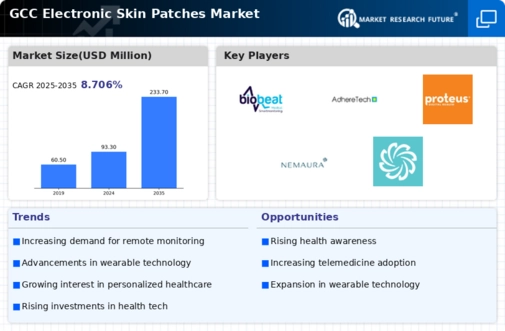Advancements in Material Science
Advancements in material science are playing a crucial role in the evolution of the electronic skin-patches market. The development of flexible, biocompatible materials enhances the comfort and usability of these patches, making them more appealing to consumers. Innovations such as conductive polymers and nanomaterials are enabling the creation of thinner, lighter patches that maintain high performance. This is particularly relevant in the GCC, where consumer preferences are shifting towards wearable technologies that are both effective and unobtrusive. As manufacturers continue to explore new materials, the electronic skin-patches market is likely to expand, offering a wider range of applications and improved user experiences.
Integration of IoT in Healthcare
The integration of Internet of Things (IoT) technology into healthcare is significantly influencing the electronic skin-patches market. IoT-enabled devices facilitate real-time data collection and transmission, allowing healthcare professionals to monitor patients remotely. This capability is particularly relevant in the GCC, where the healthcare system is increasingly adopting digital solutions. The market for IoT in healthcare is expected to reach $200 billion by 2025, highlighting the potential for electronic skin patches to play a pivotal role in this transformation. By providing continuous health data, these patches enhance the ability to make informed clinical decisions, thereby improving patient care and operational efficiency within healthcare facilities.
Increased Focus on Preventive Healthcare
The electronic skin-patches market is benefiting from a growing emphasis on preventive healthcare in the GCC. As healthcare systems shift from reactive to proactive approaches, there is a heightened demand for tools that facilitate early detection of health issues. Electronic skin patches, which can monitor various health parameters continuously, align well with this trend. The GCC governments are investing in public health initiatives aimed at reducing the burden of chronic diseases, which is likely to drive the adoption of such innovative technologies. With an estimated 30% of the population in the region at risk for lifestyle-related diseases, the potential for electronic skin patches to contribute to preventive healthcare strategies is substantial.
Growing Investment in Health Tech Startups
Investment in health tech startups is on the rise, which is positively impacting the electronic skin-patches market. Venture capital funding in the GCC region has seen a significant increase, with health tech startups attracting approximately $1 billion in 2025 alone. This influx of capital is fostering innovation and accelerating the development of advanced electronic skin patches that cater to diverse health monitoring needs. As these startups introduce novel solutions, the market is likely to witness enhanced competition and improved product offerings. This dynamic environment not only benefits consumers through better technology but also encourages established companies to invest in research and development, further propelling the electronic skin-patches market.
Rising Demand for Remote Patient Monitoring
The electronic skin-patches market is experiencing a notable surge in demand for remote patient monitoring solutions. This trend is driven by the increasing prevalence of chronic diseases in the GCC region, which necessitates continuous health monitoring. According to recent data, the GCC healthcare sector is projected to grow at a CAGR of 10% from 2025 to 2030, indicating a robust market for innovative health technologies. Electronic skin patches offer a non-invasive method for tracking vital signs, thereby enhancing patient compliance and reducing hospital visits. As healthcare providers seek to improve patient outcomes while managing costs, the adoption of electronic skin patches is likely to expand, positioning them as a critical component in the future of healthcare delivery in the GCC.

















Leave a Comment